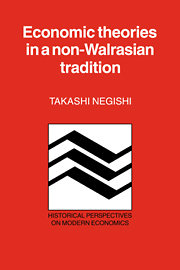Book contents
- Frontmatter
- Contents
- Preface
- 1 Anti-neoclassical or non-Walrasian economic theories
- Part I Increasing returns and diminishing cost
- Part II Wages and profit
- 6 Conditions for the wages fund doctrine and Mill's recantation of it
- 7 Marx and exploitations in production and in circulation
- 8 Marx's dichotomy between exploitation and redistribution of surplus products
- 9 Böhm-Bawerk and the positive rate of interest in a stationary state
- Part III International trade and investment
- Part IV Markets and money
- Notes
- References
- Author index
- Subject index
9 - Böhm-Bawerk and the positive rate of interest in a stationary state
from Part II - Wages and profit
Published online by Cambridge University Press: 21 September 2009
- Frontmatter
- Contents
- Preface
- 1 Anti-neoclassical or non-Walrasian economic theories
- Part I Increasing returns and diminishing cost
- Part II Wages and profit
- 6 Conditions for the wages fund doctrine and Mill's recantation of it
- 7 Marx and exploitations in production and in circulation
- 8 Marx's dichotomy between exploitation and redistribution of surplus products
- 9 Böhm-Bawerk and the positive rate of interest in a stationary state
- Part III International trade and investment
- Part IV Markets and money
- Notes
- References
- Author index
- Subject index
Summary
It is well known that Böhm-Bawerk adduced three causes for the existence of interest, Kapitalzins, defined as a premium (agio) attached to the present consumers' goods in the exchange against the future consumers' goods. They are (1) better provision for wants expected in the future than in the present, (2) undervaluation of future wants, and (3) the superiority of more roundabout or more protracted methods of production (Böhm-Bawerk 1959b, pp. 259–89, especially p. 283; see also Schumpeter 1954, pp. 927–30). The first cause implies that the marginal utility of future consumption is lower than that of present consumption, since one is given more goods in the future than in the present. If everybody is in such a situation, a positive rate of interest is necessary, because otherwise everybody wishes to borrow to consume more in the present and nobody will lend to consume more in the future. Under Böhm-Bawerk's second cause, on the other hand, the marginal utility of future consumption is lower than that of present consumption, even if one is provided equally as well in the future as in the present. In other words, the rate of interest is positive because people are myopic and consume more in the present unless the rate of interest is positive.
- Type
- Chapter
- Information
- Economic Theories in a Non-Walrasian Tradition , pp. 101 - 114Publisher: Cambridge University PressPrint publication year: 1985

